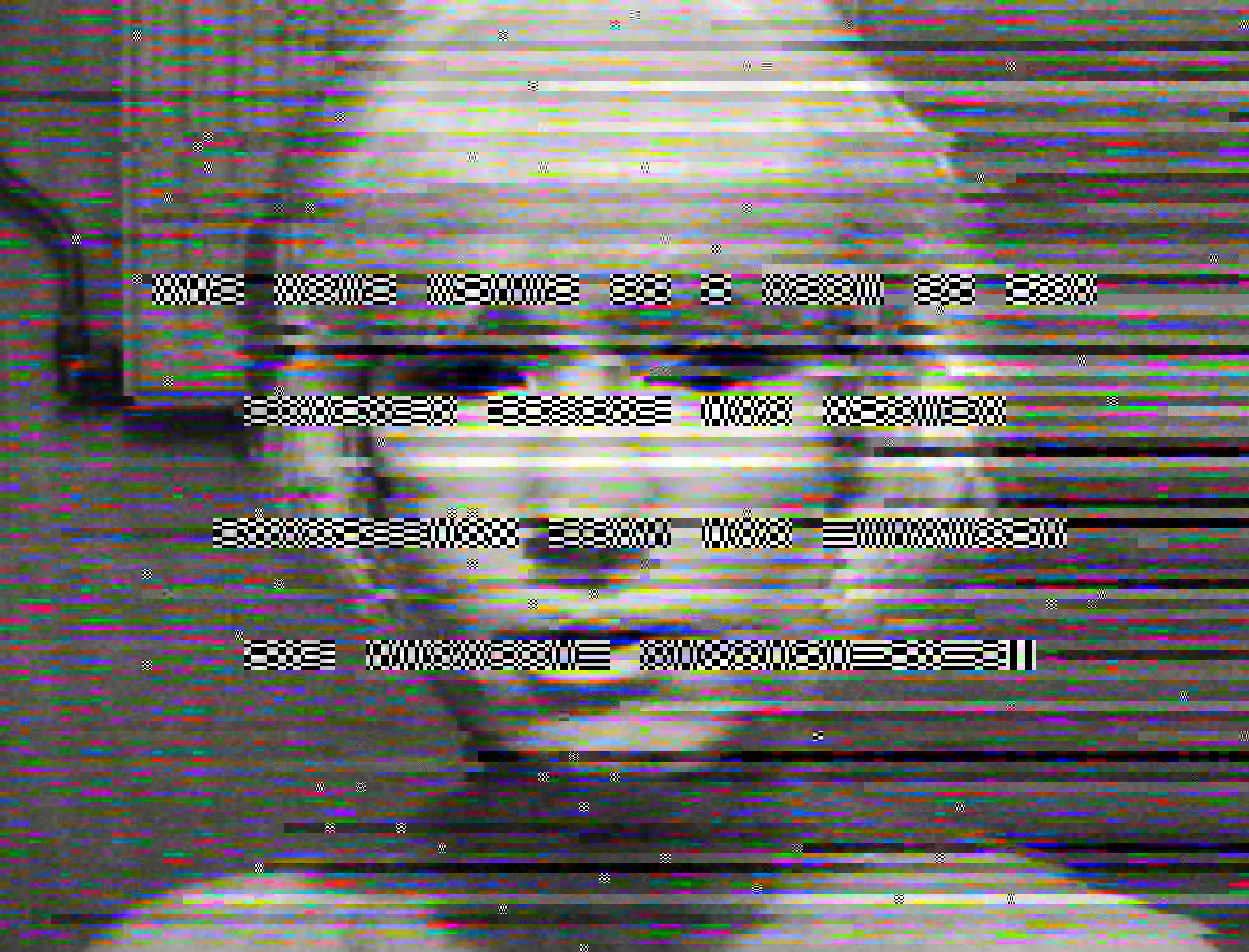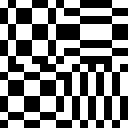Radio Dada. Music by Extraboy.
Nov 23, 2008.
Nov 23, 2008.
To Smell and Taste Black Matter (1). Music by Extraboy. Feb 15, 2009
Washmountain. Music by Extraboy.
Sep 6, 2009.
Sep 6, 2009.
Rosa Moln. Music by Extraboy.
Dec 11, 2009.
Dec 11, 2009.
65 76 65 72 79 74 68 69 6e 67 20 69 73 20 (...) Apr 17, 2010
Decay of digital data, the obsolescence of hard- and software and other unexpected breaks from the expected flow of the render pipeline result in errors, bugs, glitches or complete loss of the image.
Some glitches may momentarily reveal the underlying, often invisible structures, exposing protocol, limitations and vulnerabilities.
////////////////////////////
Vernacular of File Formats (2010)
was acquired by the
Stedelijk Museum
in 2016
PDF available here
Some glitches may momentarily reveal the underlying, often invisible structures, exposing protocol, limitations and vulnerabilities.
////////////////////////////
Vernacular of File Formats (2010)
was acquired by the
Stedelijk Museum
in 2016
PDF available here
Still upset by the loss of the analog signal PAL, the Angel unleashes her frustrations with the digital realm.
In Acousmatic Videoscapes, she manipulates the layers of digital image processing, triggering artifacts like feedback, compression and glitches. But as time passes, the ruptures she has caused seem to reveal something more than just distortion. To her surprise, the breaks expose operations that normally remain invisible, hidden within black-boxed technology.
Intrigued, the Angel examines their qualities.
A key observation comes from Un/Resolved, an 84.48 meter-long data file organised as a bitmap, encoded pixel by pixel.
The file demonstrates that digital resolution is no longer just vertically encoded (like PAL). Instead, the long, unwrapped line of data reveals that digital image resolution also uses horizontal sampling (and possibly other, meta-axes). Moreover, its final rendering depends on how hardware reads, displays and possibly changes and otherwise distorts the data.
The Angel concludes that neither the image nor its resolution are determined by image data. Instead, they are procedurally shaped by interactions between the technological apparatus and the image processing pipeline, which encompasses stages such as production, dissemination, display and reception. As a result, a digital image is never truly fixed or static; but rather dependent on constant reinterpretation at every step of the image processing pipeline and beyond.
Armed with this new understanding of resolution as an ongoing process - the Angel starts to experiment, probing different elements of the processing pipeline.
In A Vernacular of File Formats, she playfully highlights the materiality that defines digital images, by transcoding a self-portrait into various common compression formats (GIF, BMP, JPEG, etc.). When she glitches these visually identical images, their organisation breaks, exposing the otherwise hidden language on the surface of the image.
As if on a Glitch Safari, she enjoys recognizing the traces of these specific bends and breaks, documenting their protocols while describing how their codecs influence visual representation.
representation.In Acousmatic Videoscapes, she manipulates the layers of digital image processing, triggering artifacts like feedback, compression and glitches. But as time passes, the ruptures she has caused seem to reveal something more than just distortion. To her surprise, the breaks expose operations that normally remain invisible, hidden within black-boxed technology.
Intrigued, the Angel examines their qualities.
A key observation comes from Un/Resolved, an 84.48 meter-long data file organised as a bitmap, encoded pixel by pixel.
The file demonstrates that digital resolution is no longer just vertically encoded (like PAL). Instead, the long, unwrapped line of data reveals that digital image resolution also uses horizontal sampling (and possibly other, meta-axes). Moreover, its final rendering depends on how hardware reads, displays and possibly changes and otherwise distorts the data.
The Angel concludes that neither the image nor its resolution are determined by image data. Instead, they are procedurally shaped by interactions between the technological apparatus and the image processing pipeline, which encompasses stages such as production, dissemination, display and reception. As a result, a digital image is never truly fixed or static; but rather dependent on constant reinterpretation at every step of the image processing pipeline and beyond.
Armed with this new understanding of resolution as an ongoing process - the Angel starts to experiment, probing different elements of the processing pipeline.
In A Vernacular of File Formats, she playfully highlights the materiality that defines digital images, by transcoding a self-portrait into various common compression formats (GIF, BMP, JPEG, etc.). When she glitches these visually identical images, their organisation breaks, exposing the otherwise hidden language on the surface of the image.
As if on a Glitch Safari, she enjoys recognizing the traces of these specific bends and breaks, documenting their protocols while describing how their codecs influence visual representation.
Unresolved (84.48-meters-long data file painted on canvas, partially wrapped, 2016)
UnResolved is inspired by
Beflix 29 PARALLEL STRIPES
UnResolved is inspired by
Beflix 29 PARALLEL STRIPES
///////////////////////////
DCT:SYPHONING. The 64th interval (2015)
was conceived during my
Oregon Story Board residency
2016 - 2017
and finished during my time at
Schloss Solitude
DCT:SYPHONING. The 64th interval (2015)
was conceived during my
Oregon Story Board residency
2016 - 2017
and finished during my time at
Schloss Solitude
On one such trip, she observes a senior Discrete Cosine Transform (DCT, a key algorithm in JPEG compression, that converts 8x8 blocks of pixel intensities into 64 frequency components), instructing a Junior DCT how to transcode data from one compression language to another,
or as they call it: how to ‘SYPHON.’
In a scene reminiscent of Edwin Abbott Abbott’s Flatland (1884), Junior and Senior DCT Syphon from one Ecology of Compression Complexity to a next. At first, they transcode simple artifacts such as pixels, scanlines and macroblocks. However, as they navigate into more complex realms, such as wavelets and vectors, they reach the limits of their own complexity and ultimately fall into kernel panic.
From a PenRose-Stairs to Nowhere, just one upgrade away, the Angel tries to help. She commits to the DCTs: Try to render like information! Unlike data, information spans multiple dimensions. It renders in various directions and not just North!
But the DCTs have reached stack overflow and have syphoned back to simpler complexities.
The Angel realizes then that upgrading image technology is a Paradox: efforts to optimize, clarify and advance will also inevitably introduce new limitations, filters and bias.
Refusing to let this new found insights - the Upgrade Paradox - go to waste, the Angel develops a fork (modification) of the DCT algorithm, by mapping each of its 64 distinct blocks to the most frequently used characters of the Roman alphabet. A method that allows her to steganographically encode messages as DCT error, transforming DCTs’ limitation into a new form of communication.
Possibly remediating a future DCT SYPHON.
To her, the DCT encryption method is more than just a poetic, steganographic tool; the fork provides radical access to the inner workings of a JPEG, enabling precise manipulations within the Huffman table. A process that illustrates how compression fundamentally alters the essence of image data, transforming image resolution into material evidence of transcoding.
or as they call it: how to ‘SYPHON.’
In a scene reminiscent of Edwin Abbott Abbott’s Flatland (1884), Junior and Senior DCT Syphon from one Ecology of Compression Complexity to a next. At first, they transcode simple artifacts such as pixels, scanlines and macroblocks. However, as they navigate into more complex realms, such as wavelets and vectors, they reach the limits of their own complexity and ultimately fall into kernel panic.
From a PenRose-Stairs to Nowhere, just one upgrade away, the Angel tries to help. She commits to the DCTs: Try to render like information! Unlike data, information spans multiple dimensions. It renders in various directions and not just North!
But the DCTs have reached stack overflow and have syphoned back to simpler complexities.
The Angel realizes then that upgrading image technology is a Paradox: efforts to optimize, clarify and advance will also inevitably introduce new limitations, filters and bias.
Refusing to let this new found insights - the Upgrade Paradox - go to waste, the Angel develops a fork (modification) of the DCT algorithm, by mapping each of its 64 distinct blocks to the most frequently used characters of the Roman alphabet. A method that allows her to steganographically encode messages as DCT error, transforming DCTs’ limitation into a new form of communication.
Possibly remediating a future DCT SYPHON.
To her, the DCT encryption method is more than just a poetic, steganographic tool; the fork provides radical access to the inner workings of a JPEG, enabling precise manipulations within the Huffman table. A process that illustrates how compression fundamentally alters the essence of image data, transforming image resolution into material evidence of transcoding.

///////////////////////////
DCT is a software that lets you write in error.
The first iteration was build by Ted Davis,
a second by Erik Axel Eggelink.


